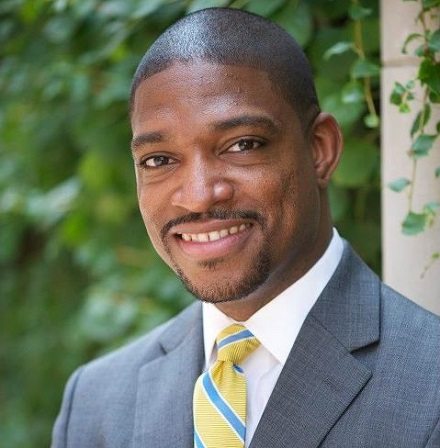
Image Credit: The Deaconess Foundation
Since November 18, 2014, Rev. Starsky Wilson has worn three hats—as a minister of the United Church of Christ and pastor of St. John’s Church in St. Louis, as CEO of the Deaconess Foundation, a faith-based health conversion foundation, and as co-chair of the Ferguson Commission. Missouri Governor Jay Nixon created the commission with the charge to “study the underlying social and economic conditions underscored by the unrest in the wake of the death of Michael Brown…[and as a result] to help chart a new path toward healing and positive change for the residents of the St. Louis region.”
At a time when progress on racial issues seems to have staggered in the aftermath of the Ferguson unrest, compounded by additional incidents in California and New York regarding police killings of unarmed black men, Wilson’s perspectives on philanthropy and racial justice may have outsized significance for nonprofits and foundations if the Ferguson Commission makes some headway beyond issuing a heartfelt report that is welcomed, lauded, and forgotten. The functions of the Ferguson Commission and the grantmaking of the Deaconess Foundation comprise a complex, contentious, and high risk venture for responding to the dynamic that followed the deaths of Michael Brown and others.
The Ferguson Commission role and the Deaconess Foundation’s grantmaking activism in response to the events in Ferguson have vaulted Wilson to significant national visibility in new and emerging contours of organizing for racial justice. Particularly notable is Wilson’s role as a foundation leader willing to invest in community organizing during a tumultuous time. In September, Deaconess granted $100,000 for staff community organizing positions to the Organization for Black Struggle, chaired by Montague Simmons, and the Youth Council for Positive Development, paving the way for other foundations with more capital such as the Open Society Foundations to make a larger grant commitment to OBS and Missourians Organizing for Reform and Empowerment.
As Rev. Wilson noted during a webinar sponsored by the National Committee for Responsive Philanthropy (NCRP) on January 15th, that kind of grantmaking reflects the foundation’s commitment to community capacity building to build and support indigenous community leadership. Wilson pointed out to the NCRP audience that the St. Louis region had only one community organizing group with a budget over $300,000 and none with African-American leadership. In fact, Wilson noted that he had to dissuade other national foundations from making grants to community organizing networks without any infrastructure in Ferguson, or even in St. Louis. If an organizer needs to book a room at a long-term stay hotel, Wilson observed, the organizer isn’t really part of the community.
It is this kind of straight talk that will be called upon in Wilson’s role leading the Ferguson Commission—or, to be precise, co-chairing it with a retired executive from a major corporation in the St. Louis region. (The notion that corporate leadership would be critical to the success of the Ferguson Commission is, in itself, interesting. Its importance may have been viewed by some as a necessary leavening factor to temper the advocacy and, perhaps, the anger of the people of color who might be frustrated with the turn of events in the region—the grand jury’s failure to bring an indictment against Darren Wilson, the police officer who killed Michael Brown; the questionable actions of the St. Louis County prosecutor both before and after the grand jury decision; and the U.S. Justice Department’s decision to clear the Officer Wilson of potential civil rights charges.)
Rev. Starsky Wilson is measured and thoughtful in his statements, both to us in an interview on January 13th and in the NCRP webinar. He has had to be, given the contentious dynamic of some of the public meetings held by the commission at the time he spoke to NPQ. The format of the public meetings has been one of providing the opinions and research of experts followed by a large group session with an open mic for community members, then smaller breakouts. Wilson’s emphasis on community is not simply affording community residents an opportunity to vent. Wilson cites the model of Rev. Martin Luther King Jr., saying, “You must win locally to have the conversation nationally and globally.” To Wilson, that’s the importance of convening a Ferguson Commission dynamic that addresses macro-issues that in no way can be “solved” at the local level. “If policy change is not made at local levels, and I include that here,” Wilson said, “then we’re not going to be able to sustain a [national] movement for justice and equality.” If the commission works as it might, Wilson contends, it will do more than produce research on ideal models and issue recommendations that may or may not be implemented; it will function as a “bully pulpit of its own, particularly as it relates to poverty.”
Whatever the commission yields, success, failure, or irrelevance, Rev. Wilson’s other identity as a philanthropic leader will still be called upon for leadership in the foundation community as it struggles to address issues of racial equity. With some modesty, Wilson explains that the Deaconess Foundation that he leads, a health conversion foundation created from the purchase of Deaconess Incarnate Word Health System to the for-profit Tenet Health System, is trying to learn from other foundations that are engaged in movement building. He cites conversations he is having with the Philanthropic Initiative for Racial Equity, headed by former C.S. Mott Foundation program officer Lori Villarosa, the Neighborhood Funders Group, an affinity group which sees itself as building the capacity of philanthropy to advance economic and social justice for people in low and moderate income communities, and NCRP, the nation’s original philanthropic watchdog.
One of Wilson’s important observations is about the importance of smaller foundations like Deaconess taking on these issues. While he admires the multimillion-dollar investment of the Open Society Foundations in police reform and has engaged in conversations with the foundations addressing the challenges of boys and young men of color, he notes that much of philanthropy on social justice or racial issues “tends to be on a national scale and urban or city-centric.” Inner-ring suburbs like Ferguson “lack the philanthropic and social service infrastructure that our cities have,” he notes, and when they are faced with issues such as the civil rights crisis of Ferguson, they don’t have the civil society capacity to respond. “Smaller foundations like ours have the opportunity move more quickly,” Wilson says, but the key isn’t just to make grants, but to invest in capacity in the inner ring suburbs.
How does a health conversion foundation end up investing in movement building capacity? Wilson explains that Deaconess is both a health conversion foundation and part of the ministry of the United Church of Christ. The focus of the foundation is the wellbeing of children. That takes the foundation into examining and understanding the social determinants of the health of children from a “public health frame.” As a result, the foundation finds itself not really investing in health clinics or hospitals, Wilson says, but in the people and groups that are advocating for a healthier environment for children in the St. Louis region. There are 220 churches in the United Church of Christ community of greater St. Louis, Wilson adds, whose advocacy on children’s issues and capacity toward sustaining activism could go a long way toward achieving “collective impact” in this arena. It is worth noting that Michael Brown was only 18 years old when he was killed—a man in the eyes of some, but only a kid whose life was ended before it had much of a chance to start in the eyes of many others. A public health frame toward child wellbeing means protecting young men like Michael Brown and reducing or eliminating the circumstances, including inappropriate and over-aggressive policing, that led to his death.
To make headway, either as a foundation building community capacity or a commission addressing the circumstances that directly and indirectly contributed to Michael Brown’s death, Wilson confronts a thicket of issues. St. Louis County contains 90 municipalities. Add the city of St. Louis itself and there are 91 municipal jurisdictions to sort through to fashion a more productive, positive dynamic for the million residents of the county, one third of whom live in unincorporated areas, and the 318,000 residents of the city of St. Louis. Wilson talks about looking at the “ecosystem” of the region, but its governance has long made social progress around issues of equity hard to realize.
Sign up for our free newsletters
Subscribe to NPQ's newsletters to have our top stories delivered directly to your inbox.
By signing up, you agree to our privacy policy and terms of use, and to receive messages from NPQ and our partners.
Wilson notes the oddly perverse dynamic of the police and court structure of the county. Bloomberg View editorial writer Christopher Flavelle has described the “crazy quilt” structure of small municipalities in St. Louis County, each with their own police forces and other municipal functions that often survive on revenues from the courts—that is, revenues from traffic tickets and other minor police actions. As costs increase, the pressure on the police is to write more tickets and generate more money, essentially compelling police to take an adversarial position toward residents.
According to Wilson, the result is that “police time is being taken up with negative interactions such as ticketing, feeding the courts, and taking time away from things like the police athletic league.” It is part of the commission’s dual identity: half a kind of “truth commission” to uncover and reveal past governmental wrongdoing, intentional or otherwise, with the goal creating a dynamic of healing, and half a “riot commission” like the Kerner Commission of the 1960s, meant to generate policy proposals to change the underlying conditions that lead to civil rights issues. In the latter, examining what Wilson says might have led to the “conflagration,” the commission has to address issues of poverty, housing, and transportation, not just police-community relations.
Wilson acknowledges that the timeframe of the Ferguson Commission, with its emphasis on a community dynamic, is not fast. President Obama’s Task Force on 21st-Century Policing, co-chaired by Philadelphia Police Commissioner Charles Ramsey, convened only in mid-December, will issue its final report before the Ferguson Commission. But Wilson says that the Ferguson Commission needs to hear the voices of hundreds of citizens before it can issue its findings and recommendations. “We cannot come to solutions without listening,” Wilson explains, and that means not only public hearings and forums, but a transparent process in which everything that is produced by the commission—interim reports, task force reports, minutes of public hearings—are put on the commission’s website for the public to see and read before the next commission meeting.
For Wilson, the work of the Commission was meant to be consistent in process as well as substance. He reports that in the commission’s very first meeting, “The community told us how it wanted us to work; we asked them to share their hopes and their concerns.” It led to a process of diverse gatherings, of meetings held in different locations, a commitment to transparency and community engagement, and a strong commitment of independence from government.
Independence from government, or the lack of it, was problematic in earlier commissions, Wilson says, leading to their being under-resourced and having to go back to government for staff functions. The funding for the Ferguson Commission comes two-thirds from state government and one-third from private sources, allowing the commission to select its own staff and run its own operations, with its financial functions handled by the United Way rather than processed through government. That independence enables the commission, Wilson says, to “raise difficult questions that it might not have otherwise” if its operations had been constricted by government offices controlling its resources. The hybrid nature of the Commission’s funding, however, does create issues, like the questions that were raised recently about the commission’s selection of public relations, facilitation, and design consultants without seeking competitive bids.
One shouldn’t imagine that the Commission has quickly reached a collective kumbaya moment in its gathering of civic and corporate leaders to address the aftermath of the Michael Brown killing. On the NCRP webinar, Wilson commented that one of the Ferguson Commission members suffered a significant cut in her organization’s receipt of corporate grants because she was on “the front lines.” He noted that other corporate funders have found it “safe” to fund training in Kingian nonviolence techniques in Atlanta as opposed to investing in the rebuilding of small businesses that were damaged in the Ferguson disturbances.
Neither is it a cakewalk for the commission’s relationship to the community in general. The issues are raw, and the discussions at the open mic sometimes contentious and tense. An early news report in the St. Louis American noted that at the first two meetings of the commission, the hearings were disrupted by some people who wanted to be heard and others who specifically didn’t want some others to speak. Part of that dynamic may have been attributable to the lengthy protocols for organizing the first meetings, long explanations of how the commission would work, with the result that residents had to wait some time before being able to speak.
The process has calmed down a bit, but one speaker at the January 20th hearing bemoaned the absence of protests at the hearings. A resident named Patrick Fox had this to say about one of the earlier commission hearings:
“That evening we had a lot of vigorous, active, boisterous protesters. I kind of missed that. I don’t miss necessarily all the loudness and the confrontation, but I miss them not being here. This Commission is a result of those protesters and yes, [if] we fix the police issue and the municipal court issue, we will improve lives, but if we get these two issues fixed, education and preserving and developing healthy, intact families—these are the game changers that make generations do better. And if somehow or another this Commission can energize hundreds of people on the street demanding better schools, better teachers, more funding, making grades not babies, waiting to form your families until when you’re ready…these are the things that pull people out of poverty, keep people out of the street, get them employed, and make a better society”
One might not necessarily buy all of Fox’s analysis, but he captures the importance of a movement, of citizens mobilized to demand actions. He also reflects longstanding experience, whether intentionally meant or not in his statement, that the best recommendations of commissions, from the Kerner Commission on, have virtually no chance of enactment, much less sustainability, unless there is the political momentum informed by community movements to see solutions surfaced, pushed, and implemented. That is where the intersection of Rev. Starsky Wilson’s leadership of the Ferguson Commission and his leadership of the Deaconess Foundation intersect. The commission is searching for authentic solutions emanating from the community; the foundation is looking to build the capacity for a community-based movement that will attack the social, economic, and police inequities that created the conditions for the killing of Michael Brown and the racial dynamics that are simply getting worse in this hardly post-racial society we live in.











